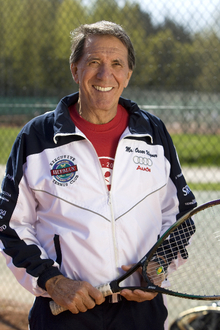The US tennis industry could grow exponentially with simple means- Oscar Wegner
September 11, 2012
There have been several tennis booms of sorts. Europe’s, right now, is flourishing.
Australia and the US dominated the upper echelons of tennis for most of last century. The early 1980s had tennis participation above 40 million in the USA alone. Today US numbers are closer to the 30 million mark. Australia is not occupying the position in tennis it once had. These two countries, with incredible financial resources produced by their Grand Slam tournaments, have growth problems that affect the entire sport. So is England, the birth place of the game.
It’s not the programs’ numbers that count. Today’s USTA’s Ten and Under Program is introducing millions of kids to this sport.
A problem still prevails: there is no permanency of new players in tennis. They experience constant failures, no control, no fun, blunting their enthusiasm for the game.
A tennis survey done in 1990 by the Tennis Industry Association and the USTA found one relevant factor that is still not met: how to make tennis easy, with quick success. The findings were never applied. Coaching emphasis is still teaching sideways, like baseball, racquet back early, hitting through the ball, resulting in power rather than control. Today’s beginners still have trouble rallying, that is, keeping the ball in play with ease.
Overseas tennis coaching has progressed by leaps and bounds, and young players learn to play like the pros, exactly. Open stance, natural moves, emphasis on finding the ball, hitting up and across, deflection and ball rotation, etc., in essence, using nature and natural forces to help, rather than oppose.
The great majority of US coaches, on the contrary, have stuck to the older, more linear model, in which the player hits forward flat rather than eliciting a longer contact across the strings. Why?
In the US two professional tennis teachers’ associations, the USPTA and PTR, handle education to more than 30,000 coaching members. Both have shied away from accelerating the modernizing of coaching techniques to protect their older products and their zone of control. They should consider the good of all, seeing that tennis grows in numbers and in quality, thereby assuring their own survival and growth.
Another factor is the emphasis of Sport Science for Tennis focusing attention on the position of the feet. While apparently valuable, too much attention to footwork is another barrier that minimizes feel for the ball. You learned to move when you were two or three years old. Tennis prowess thereafter is in your hands, not your feet.
The player, confused, gets stuck mid-development and does not exhibit good ball control. It is a frustrating experience for newcomers and more times than not it results in abandoning the sport.
Young children are particularly susceptible to this scenario. A child wants to succeed, especially in front of his peers, in anything he tries. The dismal retention of the Ten and Under Program is witness that something is amiss. This is not a difficult sport.
Further, applying conventional, trite concepts, even while mixing them with some modern tennis tenets is like oil and water poured together: they don’t mix.
Solution: promote modern tennis methodology to the masses. Insist on techniques that maximize hand-eye coordination, feel, instinct, natural moves, and keeping the ball in play.
About Oscar Wegner
Oscar Wegner played the international tour in the 1960s and then dedicated himself to coaching. Starting in 1968 as Pancho Segura’s assistant at the Beverly Hills Tennis Club in California, he has coached from Gustavo Kuerten, winner of three French Opens, in his younger years, up to Bjorn Borg in his second comeback in 1992 and was Spain’s Jr. Davis Cup Captain in 1973.
Oscar Wegner has been a tennis commentator for ESPN for Latin America from 1994 through 1999, and is a writer, and producer of numerous books, articles and instructional DVDs.
His famous Play Like the Pros tips on ESPN International were broadcast to more than 150 countries, including during Super Bowl and NBA FInals, which generated billions of impressions. He also publishes www.tennisteacher.com to forward his modernizing tennis techniques to the masses, inspiring, with his teachings, parents such as Richard Williams to develop their children into tennis stars.
{jcomments on}


